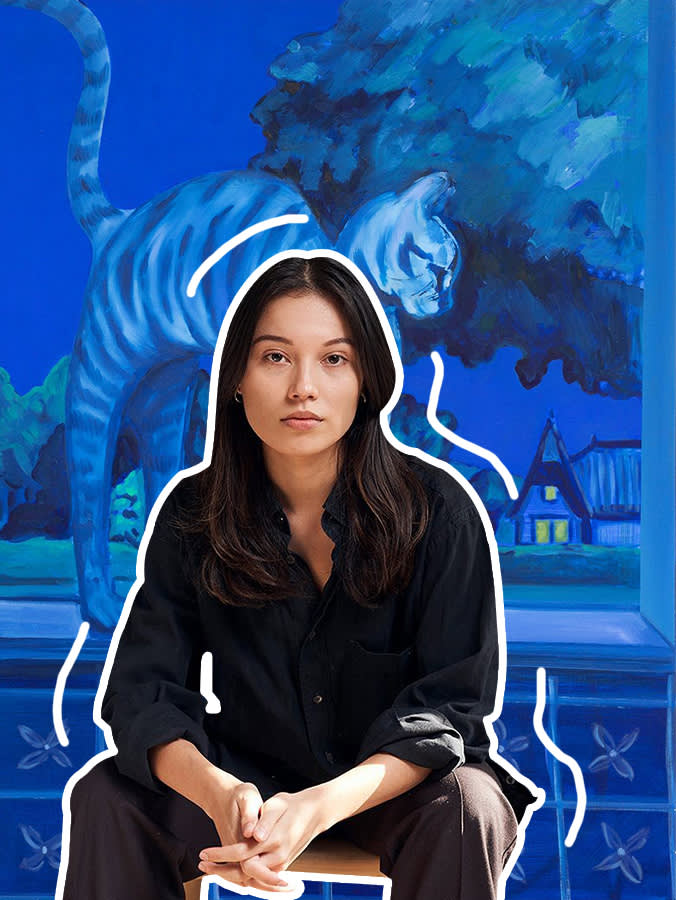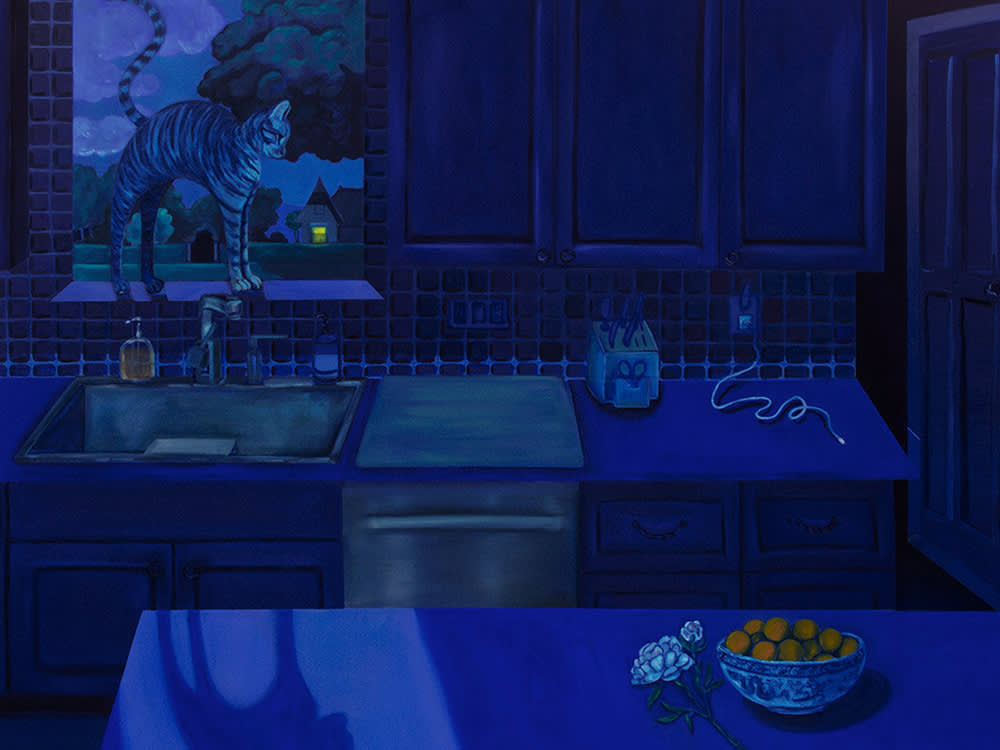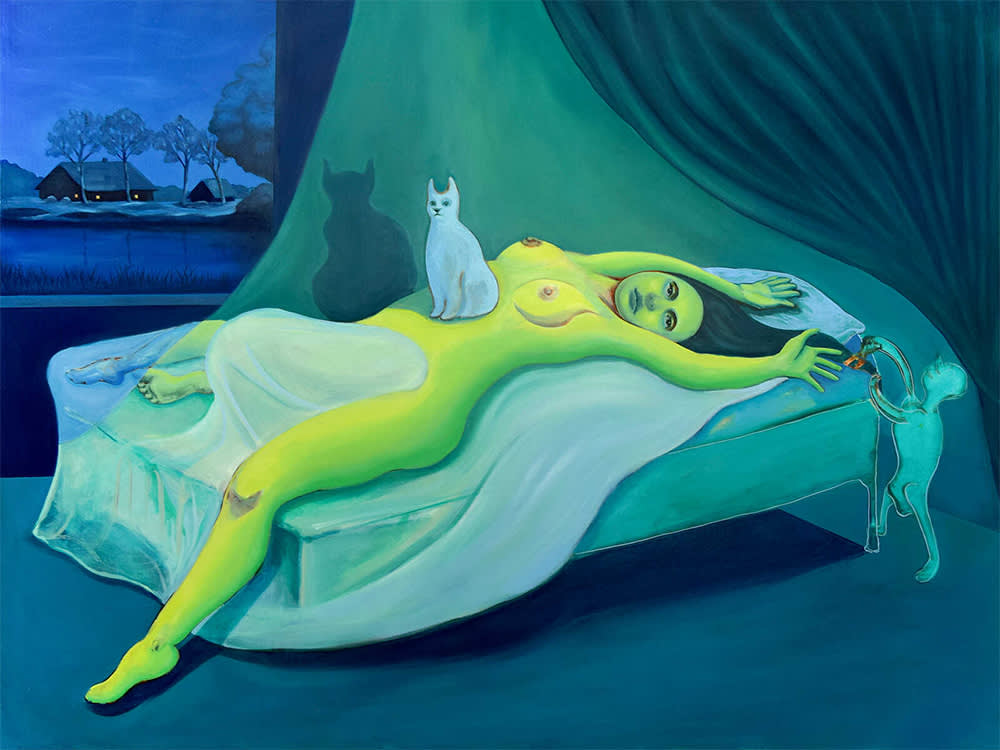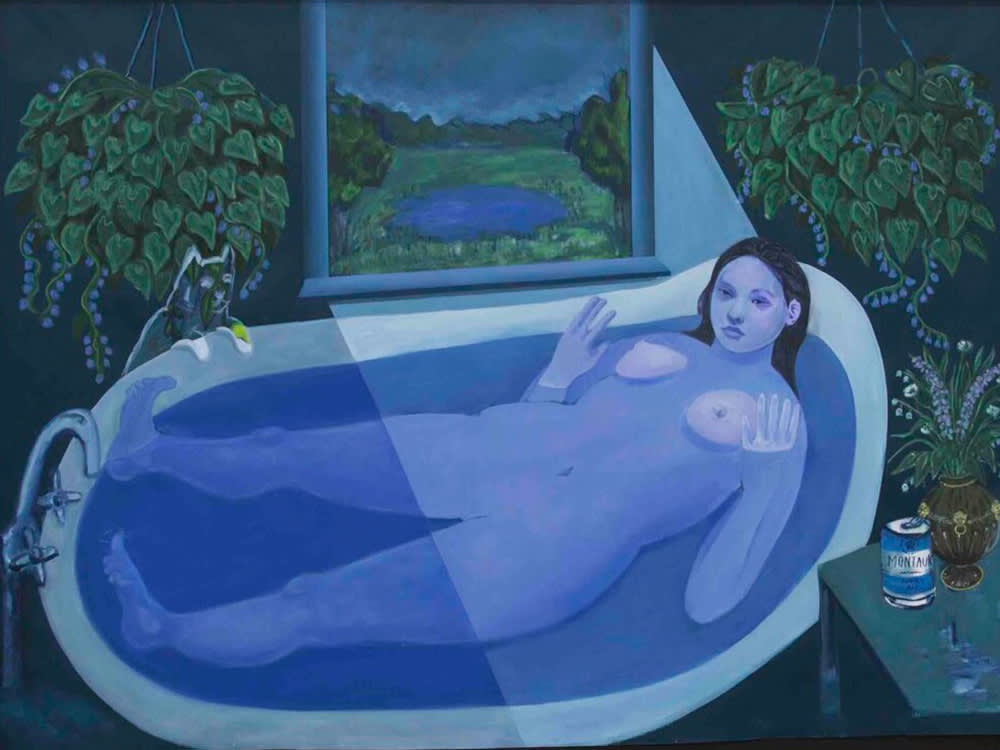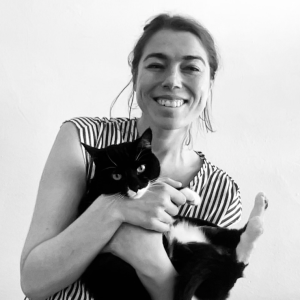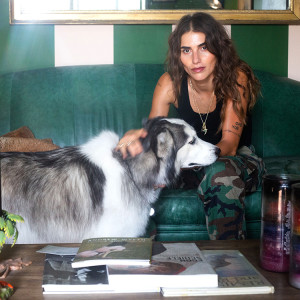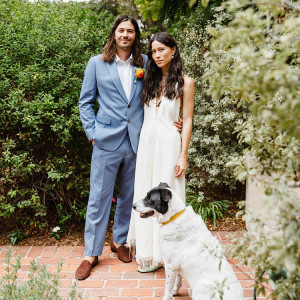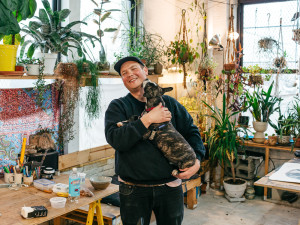Bambou Gili’s Paintings Are For Cool Cats Who Thrive in the Midnight Shadows
The dreamy hues of the visual artist’s work reflect the magic found in quiet moments. Something kitties appreciate, too.
It’s really hard not to gaze, lingeringly, at the work of visual artist Bambou Giliopens in new tab. The NYC native is currently exploding on the contemporary art scene, thanks to her paintings, which practically hum to admirers in hues of blue, green, and purple. It also helps that these paintings depict modern, incredibly relatable topics such as isolation, vulnerability, race, playfulness, and intrigue. Also, bonus: If you look closely, you can often spot cats.
Gili’s own rescues, Mo, a tabby, and Marmalade, a gregarious ginger, make cameos in her work. The former even stole the show in her piece “Vet Odyssey” (2022), which was unveiled at Frieze London in Octoberopens in new tab. The anxious, hurrying cat parent in the painting resonated with pet lovers.
We caught up with the very busy Gili, whose work was just featured in a showopens in new tab at the prestigious Los Angeles Deitch gallery and who will have her first solo exhibition at Night Gallery (also in LA) next year. She spoke to Kinship about the creative intersection between art and felines, as well as the goofy challenges of inviting your pet into an art studio.
Many of your paintings are set at twilight or at night. How do you use night in your work?
For me, it’s much easier to loosen reality at night. In the day, there’s clarity in how light defines the shapes of our surroundings. At night, light bends and contorts familiar shapes and transforms the world according to whatever silhouettes the brain can make sense of. Your own psychology plays an interesting part in constructing this terrain. If you’re feeling peaceful, moonlight may turn the landscape into an ethereal dreamscape; if you’re paranoid, it may create an eerie shadowland.
How much do you spend on your pet per year?
Light plays tricks at night, which makes it an interesting time to make color studies. My nighttime color studies are ongoing investigations. I imagine I will spend years observing — and hopefully mastering — the depiction of natural light as it appears at all hours. I am slowly introducing new color spectrums to my palette as I work, but I’m in no rush.
I related instantly to your depictions of people reading at what looks like 2 a.m. What do you get up to at night? Do you like working then?
When I was younger I was an insomniac, but now I prefer to work while it’s light out. Night is when I reflect on observations I’ve made over the course of the day; I sketch and write down ideas that arise as I’m winding down. I keep a journal by my bedside in case a crazy idea or image for a painting pops up, and then I try to tackle it the next day. I’m a big fan of reading before bed to set myself up for great dreaming.
I used to wake up from vivid dreams pretty regularly, and I would write them in my bedside journal in the dark. They weren’t always legible, but it was fun trying to piece them together in the morning. Sometimes, they were really weird, which was great for inspiration. I once woke up next to a note that said, “Grapes are bad for dogs.” I Googled it and was amazed that it was true. Something about the idea of animals in peril made me think of Goya’s drowning dog [“The Dog (El Perro”), circa 1819–23], a theme I drew from for “Vet Odyssey,” 2022.
Your depiction of the cat peeking down at the evening bather [“Ophelia in the Tub,” 2019] captures that mix of curiosity and skepticism with which cats observe humans. Are the poses of the cats in your paintings based on personal observation?
The cat in “Ophelia in the Tub” is based on my childhood cat, Chichi, who used to guard the tub whenever I took a bath. She passed away around the time I made that painting, and I was pretty heartbroken, which is why the cat is very ghost-like in that painting. I wanted to capture her looking over Ophelia in a private moment. Cats have such distinct, indelible personalities that I think all of the cats in my work must be based from observation or memory on some level.
For example, my cats, Mo and Marmie, have both recently made it into their own paintings. Mo is the star of “Blue Kitchen” (2021), and Marm makes an appearance in “Vet Odyssey.” We adopted Mo first and then foster-failed Marm. Tiny Mo is a very shy, graceful, and sweet girl. (She reserves most of her affection for my partner and me.) Marmie is the opposite. He’s a ridiculously affectionate ginger — a big licker with an extremely loud purr. We recently discovered the Reddit thread “One Orange Brain cellopens in new tab,” and it pretty much sums up the clumsy delight that is Marm.
Are they allowed in the studio?
I dream of the day I will introduce Mo to the studio, but at the moment they love to jump in my materials, and I don’t want them around toxic chemicals or licking paint off their fur, so I make several runs into the house to give them kisses throughout the day.
And potentially gather material for new work?
Maybe!
